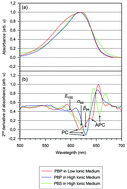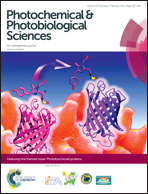Evidence of additional excitation energy transfer pathways in the phycobiliprotein antenna system of Acaryochloris marina
Abstract
To improve the energy conversion efficiency of solar organic cells, the clue may lie in the development of devices inspired by an efficient light harvesting mechanism of some aquatic photosynthetic microorganisms that are adapted to low light intensity. Consequently, we investigated the pathways of excitation energy transfer (EET) from successive light harvesting pigments to the low energy level inside the phycobiliprotein antenna system of Acaryochloris marina, a cyanobacterium, using a time resolved absorption difference spectroscopy with a resolution time of 200 fs. The objective was to understand the actual biochemical process and pathways that determine the EET mechanism. Anisotropy of the EET pathway was calculated from the absorption change trace in order to determine the contribution of excitonic coupling. The results reveal a new electron energy relaxation pathway of 14 ps inside the phycocyanin component, which runs from phycocyanin to the terminal emitter. The bleaching of the 660 nm band suggests a broader absorption of the terminal emitter between 660 nm and 675 nm. Further, there are trimer depolarization kinetics of 450 fs and 500 fs in high and low ionic strength, respectively, which arise from the relaxation of the β84 and α84 in adjacent monomers of phycocyanin. Under conditions of low ionic strength buffer solution, the evolution of the kinetic amplitude during the depolarization of the trimer is suggestive of trimer conservation within the phycocyanin hexamer. The anisotropy values were 0.38 and 0.40 in high and in low ionic strength, respectively, indicating that there is no excitonic delocalization in the high energy level of phycocyanin hexamers.


 Please wait while we load your content...
Please wait while we load your content...